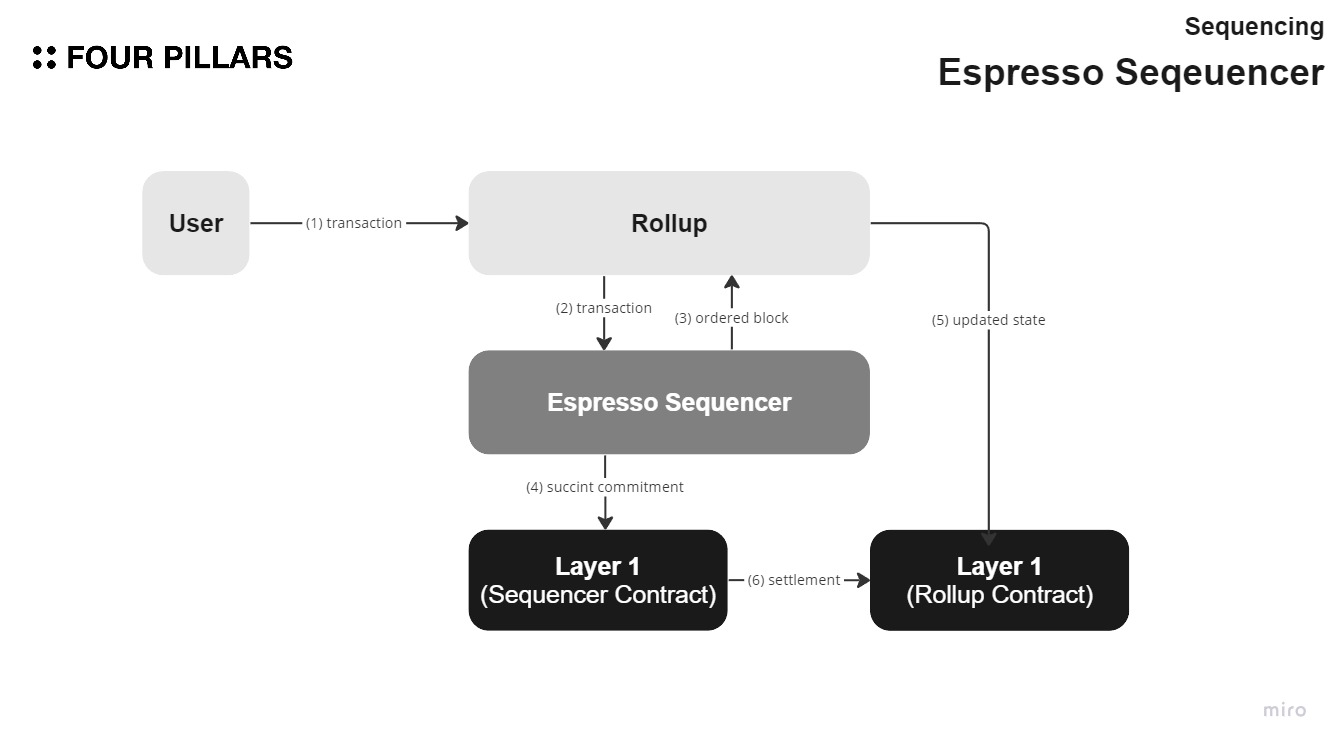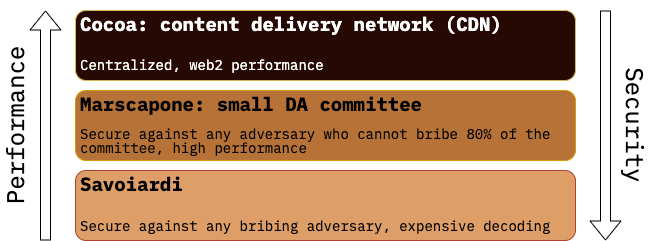Espresso Sequencer
Key Takeaways
- The Espresso Sequencer is a decentralized sequencer network that introduces a new consensus mechanism called HotShot for sequencing.
- Validators who have re-staked their ETH through EigenLayer can participate in the Espresso Sequencer.
- The Espresso Sequencer offers a powerful three-layered DA solution called Tiramisu, providing both strong security and excellent UX.
1. Overview

The Espresso Sequencer is a decentralized sequencer and DA system in the Ethereum ecosystem. The Espresso Sequencer proposes a new consensus mechanism called HotShot for transaction sequencing, with the significant feature of utilizing Ethereum validators who have re-staked their ETH through EigenLayer as a decentralized sequencer. This approach strikes a perfect balance between a base-rollup method, where sequencing is delegated to L1, and a non-base rollup method, where the rollup handles sequencing internally. As a result, the Espresso Sequencer guarantees robust security while maintaining high operational efficiency.
2. Transaction Lifecycle
The transaction lifecycle of a rollup network using Espresso Sequencer as a sequencing layer is as follows:
- Users submit transactions to each L2 network simultaneously.
- L2 networks transfer these transactions to Espresso Sequencer.
- Espresso Sequencer produces ordered blocks and sends them to L2 networks.
- Espresso Sequencer submits succinct commitment to those blocks to Sequencer Contract on L1.
- L2 networks post state roots and proofs to rollup Rollup Contracts on L1.
- Rollup Contracts read previously posted commitments from Sequencer Contract, verifying state transition proofs.
3. Sequencing
The Espresso Sequencer operates under the HotShot consensus, which is a variant of the HotStuff consensus mechanism. Ethereum validators who re-staked their ETH through EigenLayer can participate in Espresso Sequencer.
4. Data Availability

Rollups using the Espresso Sequencer can choose various DA solutions, but Espresso Systems also provides its own DA solution comprising three separate tiers of data availability called Tiramisu. It offers fast finality in the optimistic case and Ethereum network-level security in the pessimistic case. Tiramisu is operated by the Hotshot consensus and nodes.
- Savoiardi: The base layer of Tiramisu, which ensures data availability through erasure coding. However, as no single node has all the payload data, communication between nodes is required to recover full data, and the latency associated with this can harm the UX. For this reason, Tiramisu includes additional Marscapone and Cocoa layers.
- Marscapone: In the Marscapone layer, a DA committee (less than 200 nodes) is elected by the HotShot consensus to handle the data.
- Cocoa: The Cocoa layer uses a content delivery network (CDN) to achieve Web2 level performance.
5. Use Cases
5.1 Caldera
Caldera is an RaaS project based on OP-Stack, which allows the use of the Espresso Sequencer as a sequencing option. If many rollup networks are deployed through Caldera, it is expected that the Espresso Sequencer will be used by many rollups.
5.2 Polygon zkEVM
Polygon zkEVM is currently a type 3 zkEVM network, and Espresso Systems has released a demo implementing the Espresso Sequencer testnet on Polygon zkEVM. This reduces the transaction fees of Polygon zkEVM and provides faster finality through pre-confirmations.
5.3 Spire
Spire is an L3 RaaS protocol on top of zkEVMs. Its execution environment supports zkVMs such as Risc0 and zkEVMs. For sequencing, it is planning to integrate Espresso Sequencer.
5.4 AltLayer
AltLayer is a RaaS project with the feature of launching disposable rollups as a flash layer. Espresso Systems supports AltLayer in incorporating the Espresso Sequencer as an option for their developers and users.
5.5 Injective
Injective is an app-specific chain in the Cosmos ecosystem and recently started to build the first interchain SVM rollup for the IBC ecosystem, which is Cascade. Espresso Sequencer plans to be integrated into Cascade, bringing further treu decentralization to the space.
6. Team
- Ben Fisch (CEO)
- Charles Lu (Co-founder)
- Benedikt Bunz
- Jill Gunter
